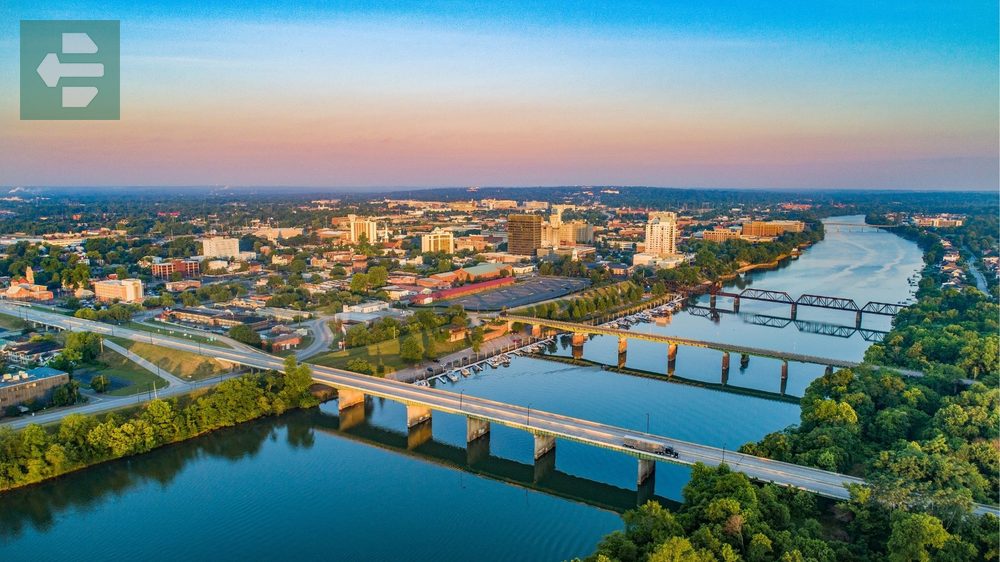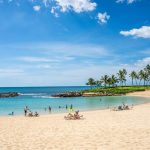Georgia offers a remarkable blend of Southern charm, mountain landscapes, and coastal beauty. From the bustling streets of Atlanta to the historic squares of Savannah, the Blue Ridge Mountains to Tybee Island's sandy shores, the state delivers experiences that range from urban sophistication to wilderness solitude.
Keep reading as we explore the best places to visit in Georgia USA that showcase the state's diverse character and hidden treasures waiting to be discovered.
List of Contents
- 1. Atlanta: Where the South Meets the Sky
- 2. Savannah: Time Moves Slowly Here
- 3. Blue Ridge Mountains: Georgia's Quiet Crown
- 4. Tybee Island: Where Georgia Meets the Atlantic
- 5. St. Simons Island: Golden Isles Elegance
- 6. Augusta: More Than Golf
- 7. Columbus: Rivers and Rapids
- 8. Macon: Music in the Air
- 9. Helen: Bavaria in the Mountains
- 10. Dahlonega: Georgia's Gold Rush Town
- 11. Jekyll Island: Millionaire's Playground
- 12. Cumberland Island: Wild and Untouched
- 13. Brasstown Bald: Georgia's Rooftop
- 14. Amicalola Falls: Georgia's Tallest Cascade
1. Atlanta: Where the South Meets the Sky
Atlanta rises from red clay hills like a modern phoenix. The city rebuilt itself after 1864 and never stopped growing. Today, it houses the world's busiest airport and some of the South's finest museums.
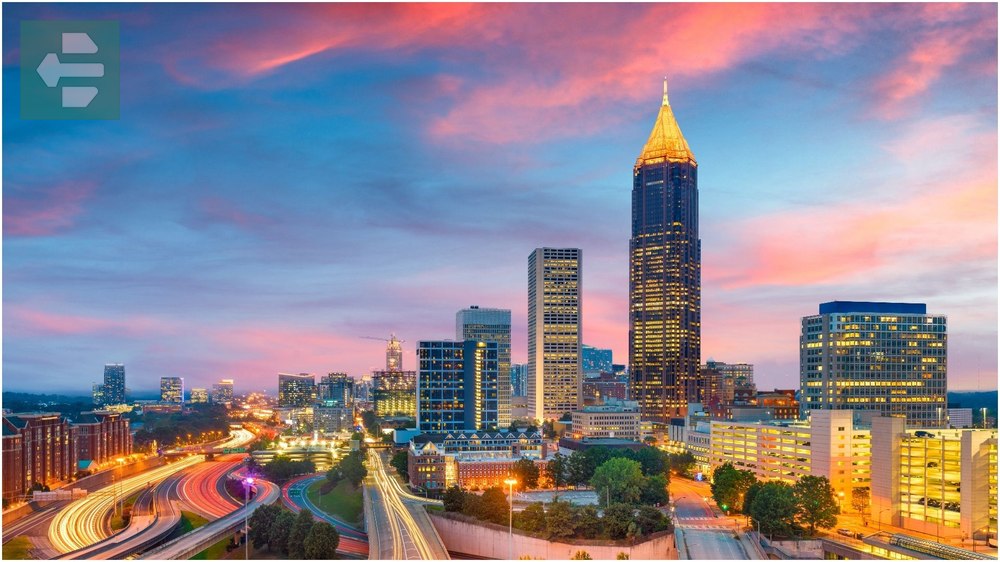
The High Museum of Art holds works that span centuries. The Georgia Aquarium contains more than 120,000 animals. Walk through Centennial Olympic Park at sunset when the fountain dances to music, and you'll understand why locals call this place home.
Skip the touristy Underground Atlanta. Instead, explore the Atlanta BeltLine—a 22-mile trail that connects neighborhoods and offers glimpses into the city's soul.
Quick Facts:
- Peak Season: March-May, September-November
- Getting There: Hartsfield-Jackson Atlanta International Airport
- Entry Fee: Free for parks, museum fees vary
- Suggested Stay: 3-4 days
- Key Attractions: High Museum, Georgia Aquarium, Fox Theatre, Martin Luther King Jr. National Historical Park
2. Savannah: Time Moves Slowly Here
Savannah's 24 historic squares create a living museum where Spanish moss drapes oak trees like nature's curtains. The city preserves its past without becoming a theme park.
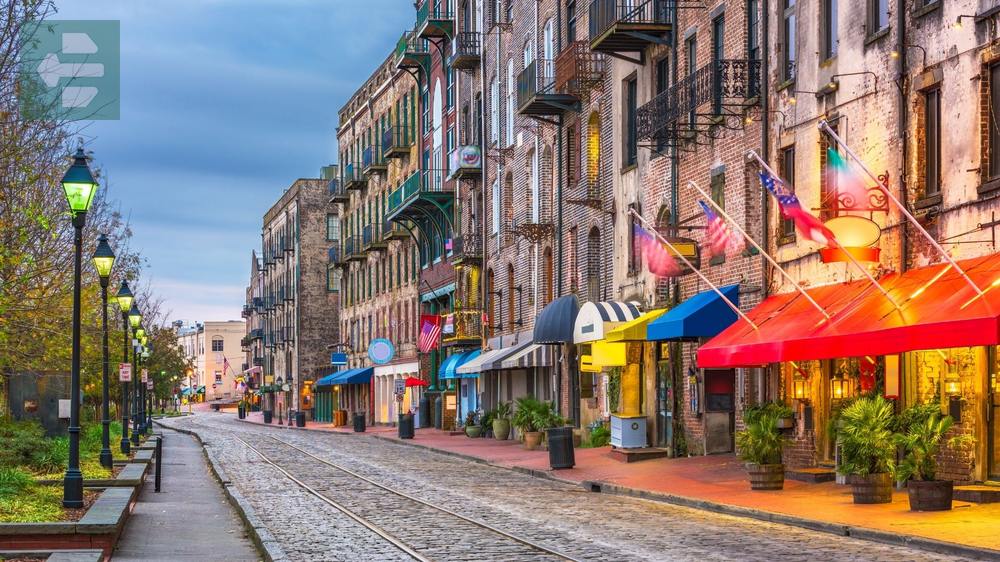
I remember walking Forsyth Park at dawn, watching joggers pass beneath trees that witnessed the Civil War. The Mercer Williams House stands quietly on Monterey Square, its secrets locked behind elegant windows.
Take the trolley tour first, then explore on foot. The real Savannah reveals itself in quiet moments between the ghost stories and tourist crowds.
Quick Facts:
- Peak Season: March-July, October-December
- Getting There: Savannah/Hilton Head International Airport
- Entry Fee: Free for squares, house tours from $20
- Suggested Stay: 2-3 days
- Key Attractions: Historic District, Forsyth Park, River Street, Bonaventure Cemetery
3. Blue Ridge Mountains: Georgia's Quiet Crown
The Blue Ridge Mountains roll across North Georgia like ancient sleeping giants. These peaks predate the Rockies by millions of years, worn smooth by time and weather.

Brasstown Bald, Georgia's highest point at 4,784 feet, offers views across four states on clear days. The drive up Highway 180 winds through forests that explode with color each October.
Local tip: Visit during weekdays when the mountain roads belong to you and the wildlife. The crowds disappear, leaving only the sound of wind through leaves.
Quick Facts:
- Peak Season: April-June, September-November
- Getting There: Various access points via US-76 or GA-515
- Entry Fee: Free for most areas, parking fees at some locations
- Suggested Stay: 3-5 days
- Key Attractions: Brasstown Bald, Amicalola Falls, Blood Mountain, Anna Ruby Falls
4. Tybee Island: Where Georgia Meets the Atlantic
Tybee Island stretches along 18 miles of Atlantic coastline just 20 minutes from Savannah. The beach town operates on island time, where flip-flops count as formal wear.

The Tybee Island Light Station has guided ships since 1736. Climb its 178 steps for views that stretch to South Carolina. At sunset, the lighthouse beam sweeps across waters that have carried everything from Spanish galleons to modern container ships.
The North Beach offers the quietest sand and the best sunrise views. Bring coffee and watch dolphins hunt in the morning surf.
Quick Facts:
- Peak Season: May-September
- Getting There: 20-minute drive from Savannah
- Entry Fee: Free beach access, lighthouse $9
- Suggested Stay: 2-3 days
- Key Attractions: Tybee Light Station, Fort Pulaski, Marine Science Center, North Beach
5. St. Simons Island: Golden Isles Elegance
St. Simons Island balances resort luxury with maritime history. The island's live oaks create natural cathedrals along streets where millionaires and fishermen coexist.

The lighthouse here dates to 1872 and houses a museum that tells stories of shipwrecks and hurricanes. Village shops sell everything from designer clothes to fresh shrimp caught that morning.
Rent a bike and ride the island's flat roads. The Spanish moss and salt air create a sensory experience that cameras cannot capture.
Quick Facts:
- Peak Season: March-May, September-November
- Getting There: Via Brunswick, 1.5 hours from Savannah
- Entry Fee: Free island access, lighthouse $12
- Suggested Stay: 2-3 days
- Key Attractions: St. Simons Lighthouse, Historic Village, East Beach, Fort Frederica
6. Augusta: More Than Golf
Augusta means golf to most people, but the city offers substance beyond the Masters Tournament. The Savannah River flows past downtown, where restored cotton warehouses now hold restaurants and galleries.

The Augusta Canal carries boats through 19th-century history. Mill ruins and wildlife refuges line the waterway that once powered the South's textile industry.
Visit during non-tournament months when hotels cost normal rates and locals reclaim their city. The azaleas bloom just as beautifully without television cameras.
Quick Facts:
- Peak Season: March-May, October-November
- Getting There: Augusta Regional Airport or 2.5-hour drive from Atlanta
- Entry Fee: Free for most attractions, canal tours $8
- Suggested Stay: 2 days
- Key Attractions: Augusta Canal, Riverwalk, Morris Museum of Art, Sacred Heart Cultural Center
7. Columbus: Rivers and Rapids
Columbus sits where the Chattahoochee River drops through shoals and rapids. The city built its fortune on water power and never forgot its connection to the river.

The RiverWalk follows 15 miles of riverbank through downtown and beyond. Whitewater rapids challenge kayakers in the city center—a rare urban whitewater experience.
The National Infantry Museum tells the story of American foot soldiers with exhibits that avoid glorifying war while honoring service.
Quick Facts:
- Peak Season: April-June, September-November
- Getting There: Columbus Airport or 2-hour drive from Atlanta
- Entry Fee: Free for RiverWalk, museum $5
- Suggested Stay: 1-2 days
- Key Attractions: Chattahoochee RiverWalk, National Infantry Museum, Springer Opera House, whitewater rafting
8. Macon: Music in the Air
Macon calls itself Georgia's heart, and music flows through its veins. The Allman Brothers, Little Richard, and Otis Redding all called this city home.

Downtown's Cherry Street Cemetery holds Duane Allman's grave, marked by a simple headstone that draws pilgrims from around the world. The Hay House showcases antebellum architecture that survived Sherman's march.
During cherry blossom season in March, 300,000 Yoshino cherry trees bloom simultaneously, creating pink clouds that rival Washington DC's famous display.
Quick Facts:
- Peak Season: March (cherry blossoms), April-May, October-November
- Getting There: Middle Georgia Regional Airport or 1.5-hour drive from Atlanta
- Entry Fee: Free for most areas, Hay House tours $12
- Suggested Stay: 1-2 days
- Key Attractions: Cherry blossoms, Allman Brothers Band Museum, Hay House, Ocmulgee Mounds
9. Helen: Bavaria in the Mountains
Helen transformed itself from a fading logging town into a Bavarian village during the 1960s. The makeover worked—tourists now flock to this alpine fantasy in the Georgia mountains.

Oktoberfest runs from September through October, drawing crowds that pack the biergartens and polka halls. Year-round, the town maintains its German theme with varying degrees of authenticity.
The real attraction lies beyond the tourist facade. The Chattahoochee River flows clear and cold through Helen, perfect for tubing when summer heat makes the mountains shimmer.
Quick Facts:
- Peak Season: September-October (Oktoberfest), June-August
- Getting There: 1.5-hour drive north from Atlanta
- Entry Fee: Free town access, activity fees vary
- Suggested Stay: 1-2 days
- Key Attractions: Oktoberfest, river tubing, alpine shops, nearby wineries
10. Dahlonega: Georgia's Gold Rush Town
Dahlonega witnessed America's first major gold rush in 1828. Miners pulled enough gold from local streams to mint coins at the town's branch of the US Mint.

The courthouse square preserves buildings from the gold rush era. Modern prospectors still pan for gold in streams where Cherokee Indians once hunted.
Visit during autumn when the town's name—Cherokee for “golden”—proves prophetic. The surrounding mountains turn colors that rival any gold nugget.
Quick Facts:
- Peak Season: September-November (fall colors), May-July
- Getting There: 1-hour drive north from Atlanta
- Entry Fee: Free for downtown, gold panning $10
- Suggested Stay: 1-2 days
- Key Attractions: Historic courthouse square, gold panning, University of North Georgia, wineries
11. Jekyll Island: Millionaire's Playground
Jekyll Island served as a winter retreat for America's wealthiest families from 1886 to 1942. The Rockefellers, Vanderbilts, and Morgans built “cottages” that resembled European palaces.

Today, the Jekyll Island Club Hotel preserves that Gilded Age elegance. The island's beaches stretch for miles, backed by maritime forests and salt marshes.
One-third of the island remains protected as wilderness. Sea turtles nest on its beaches, and dolphins play in its shallows.
Quick Facts:
- Peak Season: March-May, September-November
- Getting There: Via Brunswick, 1-hour drive from Jacksonville
- Entry Fee: $8 parking fee per day
- Suggested Stay: 2-3 days
- Key Attractions: Historic District, Driftwood Beach, Sea Turtle Center, golf courses
12. Cumberland Island: Wild and Untouched
Cumberland Island National Seashore preserves 36,000 acres of maritime wilderness accessible only by ferry. Wild horses roam beaches where Spanish missionaries once built settlements.

The island limits daily visitors to 300, creating a sense of solitude rare on the Eastern seaboard. Ruins of Thomas Carnegie's mansion emerge from maritime forests like scenes from a Gothic novel.
I spent a morning watching horses drink from freshwater ponds while egrets fished nearby. This is Georgia without development, crowds, or compromise.
Quick Facts:
- Peak Season: March-May, October-November
- Getting There: Ferry from St. Marys (reservations required)
- Entry Fee: Ferry $28 adults, $25 seniors, $18 children
- Suggested Stay: Day trip or overnight camping
- Key Attractions: Wild horses, Dungeness Ruins, pristine beaches, Sea Camp Beach
13. Brasstown Bald: Georgia's Rooftop
Brasstown Bald rises 4,784 feet above sea level, making it Georgia's highest peak. The Cherokee called it “Enotah,” meaning “where the water divides.”

A paved trail leads from the parking area to the summit visitor center. On clear days, views extend across four states. The observation deck provides 360-degree panoramas that stretch to the Atlanta skyline.
Visit early morning when mist clings to valleys below. The sunrise from Georgia's rooftop transforms the mountains into layers of blue shadow and golden light.
Quick Facts:
- Peak Season: April-October (weather dependent)
- Getting There: Via GA-180 from Helen or Blairsville
- Entry Fee: $3 parking fee
- Suggested Stay: Half-day visit
- Key Attractions: Summit views, visitor center, hiking trails, wildflower displays
14. Amicalola Falls: Georgia's Tallest Cascade
Amicalola Falls plunges 729 feet down a series of cascades and pools. The Cherokee named it “tumbling waters,” and the sound carries for miles through the forest.
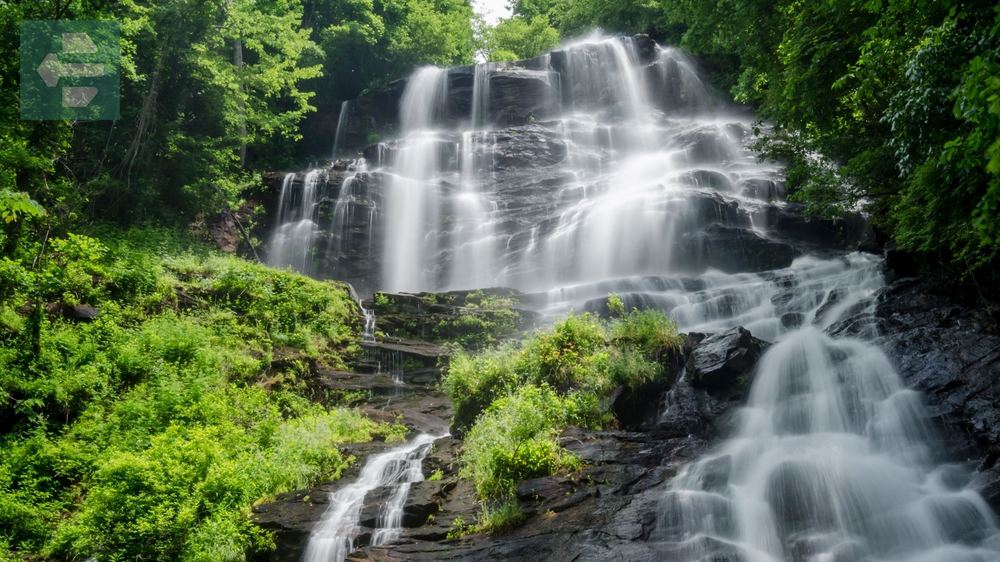
The falls mark the southern terminus of the Appalachian Trail. Hikers begin or end their 2,190-mile journey here, where dreams and determination converge.
A staircase climbs alongside the falls, but the effort rewards visitors with views that change at every turn. The base offers a different perspective—water thundering into pools carved by centuries of flow.
Quick Facts:
- Peak Season: March-May, October-November
- Getting There: 1-hour drive from Helen via GA-52
- Entry Fee: $5 park pass per vehicle
- Suggested Stay: Half-day to full day
- Key Attractions: 729-foot waterfall, Appalachian Trail access, visitor center, hiking trails
Georgia spreads its treasures across mountains, rivers, and coastlines like gifts waiting to be unwrapped. Each destination offers something different—urban energy in Atlanta, coastal serenity on the islands, mountain peace in the Blue Ridge.
The best places to visit in Georgia USA don't compete with each other. They complement, creating a travel experience that satisfies every appetite for adventure, relaxation, and discovery.
Pack light, bring curiosity, and prepare for a state that delivers more than it promises. Georgia's greatest attraction isn't any single destination—it's the journey between them, where back roads reveal secrets and small towns share stories that guidebooks never tell.
